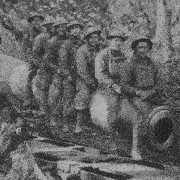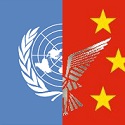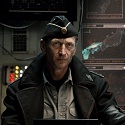|
Just found this thread, I'd like to apply to be a naval commander if it's still possible. ETA: Page snipe, sorry about that.    Update is near the bottom of previous page Update is near the bottom of previous page   
|
|
|
|

|
| # ? Apr 25, 2024 00:52 |
|
I think we need update about what new techs we opened with that and if we can start converting conventional industry into post-TNE, info about those.
|
|
|
|
Are swarm tactics viable in Aurora? I know they were in Galactic/ULTRA (and I seem to remember somewhat in 3rd).
|
|
|
|
bgreman posted:
bgreman posted:Finally, note how our mining output is now up to 5750, thanks to Administrator Farecoal's mining bonus. 
|
|
|
|
If it's not too late, I'd like to be a Ground Force Commander
|
|
|
|
Alright! We've got Trans-Newtonian capability! Guess that means I need to start designing ships. FROM: Office of Commercial Shipping, Design, and Transport TO: Civil Administrators Office (bgreman) CC: Executive Council Now that we've unlocked the keys to interplanetary travel, I feel it important to spread this knowledge to civil and industrial leaders. I would like to request a small team of researchers to begin exploring ways to Expand the Civilian Economy using trans-newtonian technology. This is an important step in modernizing our organization's capital, and should give us an important edge over our rivals in the Federation. FROM: Head of Commercial Shipping, Design, and Transport TO: Office of Research and Development (Ynkling) CC: While I'll leave the decision of how to utilize our scientific minds to you, I would recommend devoting at least ten labs to researching trans-newtonian applications in the economy. FROM: Head of Commercial Shipping, Design, and Transport TO: Office of Resource Acquisition (Puistokemisti) CC: It's too early yet to establish a commercial market for space travel, as the infrastructure to support it is not yet in place. However, my men in development are still excited by the potential and have already begun drafting blueprints for spacecraft. Here's a design for an exploratory vessel they've already drawn up: code:I urge you to put this ship or some variation of the design into production as soon as possible. These new discoveries trivialize the hurdles of interplanetary exploration, and we must exploit them as soon as possible. ((OOC: What should we name our ships after? I chose Niņa for obvious historical reasons, but I think we should establish a naming convention as soon as possible.))
|
|
|
|
|
Triskelli posted:((OOC: What should we name our ships after? I chose Niņa for obvious historical reasons, but I think we should establish a naming convention as soon as possible.)) I move we name military ships for the members of the United Nations.
|
|
|
|
Farecoal posted:
Civilian administrators in this game will have the following responsibilities:
Remember, civilian administrators are appointed by the UNEC, and can be removed from their positions with a majority vote if the UNEC can demonstrate to the United Nations General Accountability Office (me) that the administrator isn't operating in the best interests of the UN as a whole (ignoring military requests without adequate justification, etc). Frosted Flake, Mikl posted:Gimme dem characters. Done, added to Current Leaders. Triskelli posted:
From: United Nations Interplanetary Navy, Bureau of Ship Design (BuShips) To: Office of Commercial Shipping, Design, and Transport While I appreciate the well-thought out design specs, we're not yet prepared to begin building ships of this capability. We don't have any record of the "Nuclear Thermal Engine E10" and the Geological Survey Sensors you referenced are still in the very early prototype stage, not yet fit for spacecraft-rated deployment. You'll need to coordinate with the Department of Research and Development to place research orders for the things you'll need. I really really like that you presented your design in the in-game format, since it will make replicating it a snap, once we've got the required techs. That's still a ways off though. It's also not necessary, if a person doesn't want to fire up Aurora just to bang out a ship design. If a ship designer has an idea of what they want, I can work with them to show them what they'd need to make that design feasible (prerequisite techs, component designs, etc). I'm writing up the tech update now, which will also include information on player-designed components!
|
|
|
|
Mikl posted:I move we name military ships for the members of the United Nations. How about cities within the UN? More of 'em, after all, and we'll have a ton of ships eventually.
|
|
|
|
Might need to pull geographic features (ala some USN ship classes) for the stuff we're going to have lots of. Another suggestion would be to pick a member nation's naming convention for each class, so DD would be named using British shipnames, CA would be USN, etc. That way you've got some flavor variety.
|
|
|
|
bgreman posted:Civilian administrators in this game will have the following responsibilities: This is the only thing I can affect right now, correct?
|
|
|
|
Farecoal posted:This is the only thing I can affect right now, correct? That's correct. Wait for my post though, as you guys have tons more options than you did before TN Tech was researched.
|
|
|
|
Triskelli posted:FROM: Head of Commercial Shipping, Design, and Transport Oh, this is nice but can't we just fire bunch of unmanned satellites at every piece of dirt larger than gin bottle up there?
|
|
|
|
Can you add me as naval officer?
|
|
|
|
This seems pretty interesting, sign me up as a Naval Officer. Look - I've already got the rank
|
|
|
|
Jesenjin, Captain Foo posted:I AM NAVY MANS Done, updated the commanders page. As of right now, there are 11 naval commander posts still open, 4 ground commander posts, no civ admins, and 1 scientist post.
|
|
|
|
quote:Naming convention I suggest mountains of the Antarctic. Nice and neutral and one's Mt. Terror
|
|
|
|
FROM: Commanding Officer, 55th Low Tech Armour TO: Whom It May Concern As C.O of 55th Low Tech Armour  I'd like to know how mission-capible my unit is. Is there a supply screen or equipment I should be paying attention to? Should I lobby politicians to begin an upgrade program? - Colonel Frosted Flake, 55th LTA Frosted Flake fucked around with this message at 20:43 on Apr 2, 2012 |
|
|
|
Can I rename my current Missile base to something more... appropriate if I may say? How about Altentreptow in Germany? Of course it should have appropriate code name but I will leave that one to you, bgreman.
|
|
|
|
Frosted Flake posted:FROM: Commanding Officer, 55th Low Tech Armour From: XO, 55th LTA To: CO, 55th LTA RE: Readiness Sir, our unit is operating at 100% readiness and the NCOs say the boys have excellent morale. We're ready for anything. Do you want to give your unit a fancy nickname? Jesenjin posted:Can I rename my current Missile base to something more... appropriate if I may say? Missile Bases will all be named "Missile Base <City>," and yours has been renamed and your leader image updated.
|
|
|
|
bgreman posted:From: XO, 55th LTA From: CO, 55th LTA To: XO, 55th LTA RE: Unit Nickname Royal Canucks Dragoon Guards should do.  
Frosted Flake fucked around with this message at 00:25 on Apr 3, 2012 |
|
|
|
Can I have my leader image set as my avatar?
|
|
|
|
Captain Foo posted:Can I have my leader image set as my avatar? Leaders don't have dedicated images assigned to them, but we can all look at your avatar when you make a post and pretend!
|
|
|
|
If it's not too much trouble, my missile base (ICBMs, silos and all) should be relocated to Aviano.
|
|
|
|
From: United Nations Science Administration Advisory Board To: UNEC RE: The Slaan Report Analyis, Part I Sirs and madams, As you've all no doubt seen from Dr. Slaan's abstract, the new theory of Trans-Newtonian Physics and Technology devised by his team is nothing short of revolutionary. Life as we know it will be changed in every conceivable way in the coming years, with TNEs able to play a role in so many fields that even an overview of their applications will be a daunting task. Nonetheless, we have produced this condensed analysis of new avenues made available to us by Dr. Slaan's impressive work. We begin with a note on the immediate applications that require no further research. 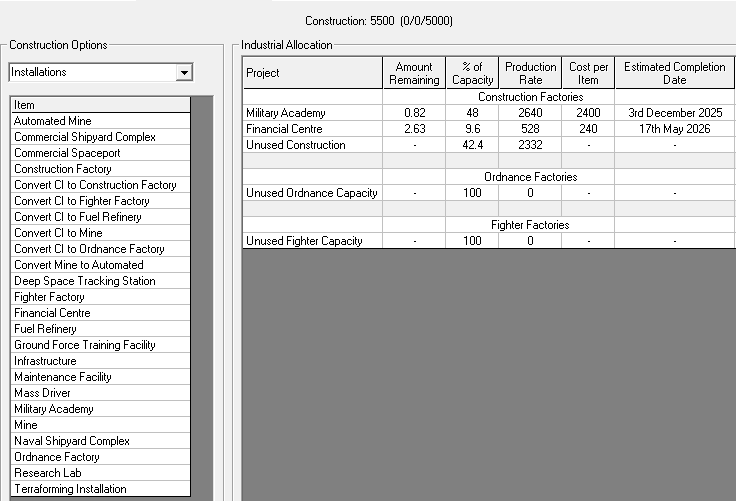 Installations In addition to the Construction Options detailed in our previous report (Financial Centres, Infrastructure, Maintenance Facilities, and Military Academies), our scientists and engineers have taken the implications of Dr. Slaan's work and applied them to a wide variety of industrial and manufacturing applications. Remember that each installation also has a wealth cost equal to its cost in construction capacity.
Part II of this analysis will detail new avenues of research enabled by the new theory of Trans-Newtonian physics. bgreman fucked around with this message at 19:07 on Apr 5, 2012 |
|
|
|
From U.N Industrial Command With the advent of Trans-Newtonian Elements into our industry, necessary conversions of our industry must begin immediately in order to gain an advantage on the Eurasian Federation. Therefore, to adjust the Industry of all U.N administrated territories, Industrial Command has mandated the following changes to Industry in the following fields: Convert 500 CI to Mines: 10% of capacity With the incredible physic's bending effects of TNE's, mining have become a much more efficient art. Mining of conventional materials is already increasing exponentially as TNE machinery makes extracting large loads of minerals from lodes and veins easier. TNE also allow easier mining of their compatriot elements, as machinery can be lowered deeper into the Earth and withstand the greater pressures and temperatures near the Earth's Mantle. Convert 4000 CI to Construction Factory: 80% of Capacity The Effect of TNE's on manufacturing has been nothing short of miraculous. Being able to subject metals and other industrial products to varying effects of gravity, various impurities found in products have been virtually eliminated. The Comms industry has also seen a boon as next-generation TNE communication devices are becoming rapidly coveted by nations and civilians. Convert 250 CI to Fighter Factory: 5% of capacity. While the orbital shipyards of Versailles and the former I.S.S provide for the multi-tonne space faring vessels of the U.N, various ground based factories have began to work towards building small 1-5 man vessels capable of rapid speeds. Thanks to TNE power cores, these vessels can easily achieve speeds not thought of for these ships nearly a decade ago. Already the civilian market is clamoring for these factories to manufacture air cars and other small craft for rapid transit across the planet. Convert 250 to Fuel Refining: 5% of capacity The energy needs for the world created a massive demand for the fuel sorium. Capable of powering large nations and vehicles with incredibly small quantities, the thirst for this fuel has seen the establishment of dozens of new refineries across U.N Territory. I hope this is an appropriate production conversion scheduled, I figure we will want a good chunk of our mines converted pronto, but the lion's share should go to our industry to make it more powerful.
|
|
|
|
Previous Research Update Everything from this update is still researchable, for the same costs as listed in that post (except Trans-Newtoninan Technology, obviously). I will not provide full descriptions for these again. They will be marked with a *. Also remember that each research project has a wealth cost associated with it equal to its cost in RP. From: UNSAAB To: UNEC RE: Dr. Slaan's Report Analysis, Part IIa  Biology & Genetics
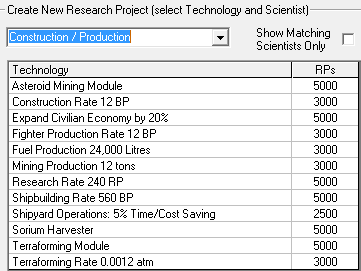 Construction and Production Replication Techs Utilizing TNEs in novel ways allows for more production to be squeezed out of the same amount of hardware. Advances in TN computing provide further performance increases. These techs all follow the basic pattern of allowing your empire to get more out of your existing assets. These techs cannot be traded or shared.
Other Construction/Production Research Projects
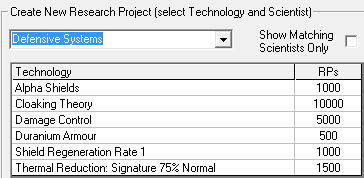
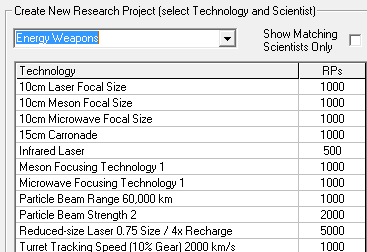
Energy Weapons Overview The energy weapons research list provides a hint at what designing components is like. Each component has several background technologies that can be set independently to configure a weapon for the desired cost-benefit balance. Component design will be covered in Part IIb of this analysis. For energy weapons in particular, there are usually two paired techs: one that determines the weapon damage, and one that determines the weapon range, often with some interplay between the two. Additionally, all energy weapons are powered by a capacitor which draws energy from a ship-based reactor. Therefore, all energy weapons depend on the capacitor recharge rate technology. \ Energy weapons are relatively short-ranged (compared to missiles, at least), but require no production or logistics support to operate them (unlike missiles, which have to be built, lugged around, and refilled in some manner). Energy Weapon Types
Jimmy4400nav posted:From U.N Industrial Command From: UN Department of Industry To: UN Industrial Command RE: Production directives You will need to pass your directives on to Administrator Farecoal for his approval and implementation. Also, do these instructions take into account the fact that Earth currently only has 42% or so production capacity free? Did you want to completely reassign the capacity percentages (putting the current projects on hold) or were your percentages relative to that 42% free (so Convert CI to Factory would get 80% * 42% = 33.6% of total industrial capacity? bgreman fucked around with this message at 19:08 on Apr 5, 2012 |
|
|
|
Jimmy4400nav posted:I hope this is an appropriate production conversion scheduled, I figure we will want a good chunk of our mines converted pronto, but the lion's share should go to our industry to make it more powerful. From: UN Civilian Administration To: UN Industrial Command RE: Production directives I see no problem with this. Approved*, pending final revisions. *The official Seal of Approval for UN offices is hereby I too would like to see my dossier, if that's okay. Farecoal fucked around with this message at 01:04 on Apr 3, 2012 |
|
|
|
From: CO, 55th LTA "Royal Canucks Dragoon Guards" To: UNSAAB RE: Military Research What kinds of research bennefit land combat forces? If our units are currently Low Tech, what will make them High Tech and what kinds of bennefits would that confer? I'd also like to see my dossier, to see what personality traits are listed.
|
|
|
|
Farecoal, Frosted Flake posted:I too would like to see my dossier, if that's okay. Your dossiers will always be listed at the Current Leaders page. Frosted Flake posted:From: CO, 55th LTA "Royal Canucks Dragoon Guards" From: UNSAAB To: CO, 55th LTA RE: Military Research Ground Forces research will be listed in part IIb of our analysis.
|
|
|
|
bgreman posted:
They were relative to the 42% that is free, although once my current projects are complete, can the freed up production capacity then be assigned to the CI conversion projects?
|
|
|
|
FROM: Dr. Slaan TO: UNEC SUB: Further research It is my recommendation that research be directed. post-haste towards Laser Focal size. This will increase the power and strength of our laser weaponry. And we all know that lasers burn commies the best. We must thusly work on lasers. QED.
|
|
|
|
Please assign my ICBM base as Offshore B (Undisclosed)
|
|
|
|
FROM: UN Dept. of ATTN: UNEC, UNCA (that's YOU, Mr. Farecoal), UNSAAB, Dr. Slaan, assorted people on my mailing list TNE Technologies: The Next Step We have five scientists with the requisite clearance levels and twenty-five research labs, totalling 5000 base "Research Points." This will be the forum for discussing their use. What I am the most interested in is creating an acceptable trade between keeping our military up to date and our industrial sector expanding. I will list out priorities and suggestions here before I parcel out our R&D resources for the next quarter. I will amend these lists as suggestions come up. Priorities
Recommendations
I'm sure we'll all have more to add when UNSAAB releases Part IIb.
|
|
|
|
Jimmy4400nav posted:They were relative to the 42% that is free, although once my current projects are complete, can the freed up production capacity then be assigned to the CI conversion projects? Hi Jimmy, I really recommend, rather than building Fighter Factories which we can't use for quite awhile, that we instead build ordnance factories that we can use
|
|
|
|
Lord Windy posted:Hi Jimmy, Are you sure? Do you want me to split between fighters and ordinance, or do you want just ordinance, because while yes we can use fighters for a while, I'd like to have the industry in place the day we have the research, rather than build after we have the research.
|
|
|
|
Jimmy4400nav posted:Are you sure? Do you want me to split between fighters and ordinance, or do you want just ordinance, because while yes we can use fighters for a while, I'd like to have the industry in place the day we have the research, rather than build after we have the research. Just Ordanance, we have to build hangers and figher engines (both 10000rp plus) before we get to build them. By that time we can spare the industry or might even have a brand new planet just for the military
|
|
|
|
Lord Windy posted:Just Ordanance, we have to build hangers and figher engines (both 10000rp plus) before we get to build them. By that time we can spare the industry or might even have a brand new planet just for the military Okay Change production order: Convert 250 CI to Fighter Factory: 5% of capacity New Order: Convert 250 CI to Ordinance Factories: 5% capacity. All other orders remain the same While the potential applications of fighter's were tempting to the U.N military forces, the necessary infrastructure to effectively field them was still years off, it was decided that instead the planed fighter factories should be converted to make conventional weapons for the plans larger ships of the future U.N Fleet
|
|
|
|
From: UNSAAB To: UNEC RE: Dr. Slaan's Report Analysis, Part IIb 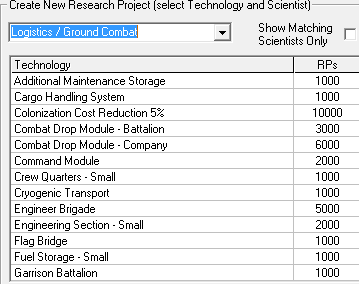 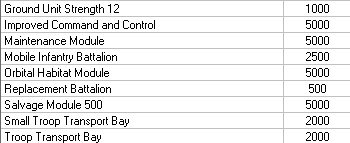 Logistics and Ground Combat Replication Techs These techs, like the ones from C&P, improve the empire's capabilities without requiring more assets.
Other Logistics / Ground Combat Research Projects
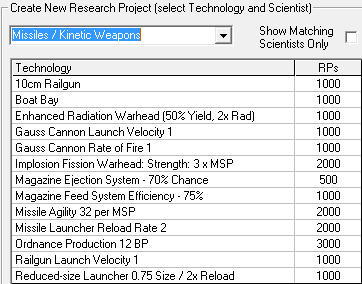 Missiles and Kinetic Weapons\ Replication Techs
Other Missile / Kinetic Weapon Research Projects
Kinetic Weapons Overview Kinetic weapons are rather similar to energy weapons in their design requirements. In fact, the game classifies energy weapons and kinetic weapons as "beam weapons," which are those that can be operated by a beam fire control sensor.
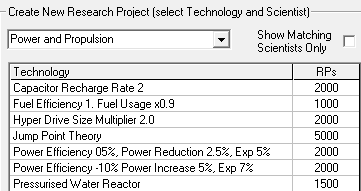 Power and Propulsion
Brief Engine Overview Engine techs are somewhat of a pain, because you have to follow an upgrade hierarchy. You first research a new reactor technology (call it ReactorTech1), which unlocks an associated engine technology (EngineTech1) and the next reactor technology (ReactorTech2). However, researching ReactorTech2 will NOT unlock EngineTech2, until EngineTech1 is researched. Missile engines are even worse, since THEY have a prerequisite of the corresponding level of EngineTech. That is, researching EngineTech1 unlocks MissileTech1, but researching EngineTech2 doesn't unlock MissileTech2 until MissileTech1 has been researched. So in this case, we have the Pressurized Water Reactor reactor tech available, which, when researched, will allow us to research Nuclear Thermal Engines, our first TN engine tech. Researching that will allow us to research Nuclear Thermal Missile Engines. (We currently have available Conventional Engine technology, which is highly inefficient, but provides a way to simulate pre-TNE rocket engines providing propulsion for TNE ship hulls. So it is entirely possible to build ships with engines right now. This was added in one of the most recent patches, so you Aurora experts might not be familiar with it. We also started the game with Nuclear Thermal Drone Engines, which allow us to design and launch missile drones already.) 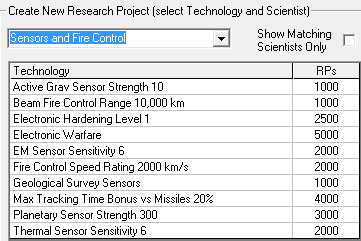 Sensors and Fire Control Replication Techs
Other Sensor / Fire Control Research Projects
Passive Sensor Overview and Introduction to Component Design Becase we have the two pre-researched base technologies EM and Thermal Sensor Sensitivity 5, we can build EM and Thermal sensors. Right now the Deep Space Tracking Network acts as a giant combined EM/Thermal sensor. 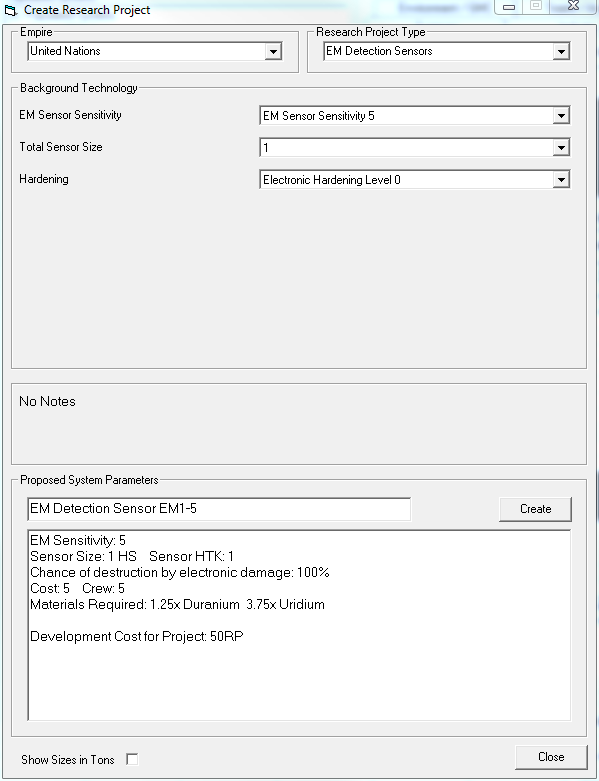 This is the component design screen. The Empire combobox allows selecting the actively designing empire. Research Project Type is one of the following list, representing the type of component we are designing:
The background technology is where you configure your component. Each component technology usually has several levels available to it (if you've researched them for applicable techs). Often there is a size parameter as well, with bigger generally being more capable but also more massive. For our EM Detection Sensor, our three background techs are EM Sensor Sensitivity, Total Sensor Size, and Hardening. These techs were all discussed above. We only have the default value for sensitivity and hardening tech available to us (Sensitivity 5, Hardening 0), but we can make the sensor any size we want between 0.1 hull spaces and 50 hull spaces (a hull space is 50 tonnes). Sometimes techs like this come pre-researched, and other times it isn't a tech at all but just a configuration option for the component, as is the case with size, here. The Notes section will contain any relevant information about equations used to calculate component effectiveness (except, inexplicably, for EM and Thermal sensors, whose formulae took me a while to figure out on my own). Proposed System Parameters lays out the performance characteristics of the component. I have left size at 1 for demonstration purposes. The parameters for different types of components differ, but some are common, like Cost (in CC or BP), Crew required to operate the component, and the TNEs required to construct it. The size is usually listed, as well as a HTK. HTK is a value that indicates how many hits it takes to destroy the component on average. With a HTK of 1, any hit destroys the component. With a higher HTK, the chance of destruction on a hit is (damage of hit / HTK). Therefore a 6 HTK component hit by a 3 damage shot would have a 50% chance of being destroyed. For EM and Thermal sensors, the performance calculation is fairly straightforward. The range at which a contact can be detected is given by: Range = Sensor sensitivity x target signature strength x 1000 km. A 10-sensitivity thermal sensor can detect the 300-signature drive plume of an enemy ship at 3,000,000 km. A 300-sensitivity sensor could detect a 10-signature plume at the same range. Sensor sensitivity is given by the product of its Sensor sensitivity background tech selection and its size in hull spaces. Using EM Sensor Sensitivity 5 and Total Sensor Size 1 gives us a Sensitivity 5 EM sensor. The Proposed System Parameters box contains a box for naming the component, so if we chose, we could name this the Raytheon SearchMaster 5000 EM Sensor. However, you usually want to give some indication of the system's capabilities, so the game defaults to the component type and a designator that attempts to communicate the abilities of the system. Here we have the "EM1-5", which means "EM sensor, 1 hull-space large, 5 overall sensitivity." Pressing Create finalizes the design.  It is important to understand what you are doing on this screen. You are not designing a component that you can immediately go plop onto a ship design. You are creating your own research project (as indicated by the window title). Think of it as creating the plans and theory for a new component. You have to construct a prototype and put it through all sorts of tests before it is field-ready. Pressing Create adds the new project to your available tech lists on the Research tab of the Populations/Productions screen. The cost for the project is shown in the Proposed System Parameters pane. It is important to understand what you are doing on this screen. You are not designing a component that you can immediately go plop onto a ship design. You are creating your own research project (as indicated by the window title). Think of it as creating the plans and theory for a new component. You have to construct a prototype and put it through all sorts of tests before it is field-ready. Pressing Create adds the new project to your available tech lists on the Research tab of the Populations/Productions screen. The cost for the project is shown in the Proposed System Parameters pane.Show Sizes in Tons converts any size display in the Proposed System Parameters pane between hull spaces and tonnes. I must admit, this mechanism, whereby you must research your components before you can build them, is what drew me into Aurora. It might seem tedious, but it adds a layer of realism and immersion that tickles me just the right way. Tomorrow I'll show the Create Research Project screens for the few other things we can design right now. Jimmy4400nav posted:Okay 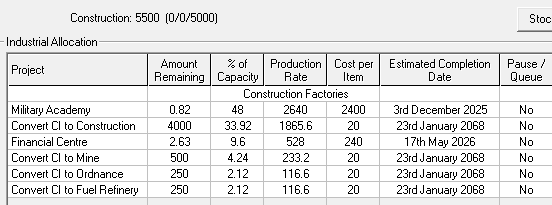 Once your other projects finish, assigning the freed-up construction capacity will bring those complete dates down (if that's what you choose to do).
|
|
|
|

|
| # ? Apr 25, 2024 00:52 |
|
bgreman posted:Foreign News, 6th March 2025 Those commies TNE blocked us! This news combined with my abject poverty and total lack of prospects has worked me up into a seething patriotism. Enlist me in the ground forces, please.
|
|
|









